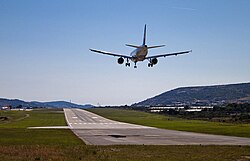
A conventional take-off and landing (CTOL), [1] also known as horizontal take-off and landing (HTOL), is the usual process whereby fixed-wing aircraft perform takeoff and landing. As fixed-wing aircraft must have a forward motion to have relative air flow over the airfoils (wings) in order to generate lift, they require a period of ground acceleration before takeoff and conversely also a period of safe, gradual ground deceleration after landing, both translating to the necessity of sufficient distance for linear ground movement, which conventionally involve the use of dedicated runways. [2]
During takeoff, the aircraft will first taxi or be tugged into a launch position at one end of the runway, where a final preflight check known as the run-up is completed. When cleared to proceed, the aircraft engines power up and the aircraft, propelled by the engines' thrust, begins accelerating down the runway in a takeoff roll with its landing gear wheels still contacting the ground. The takeoff roll ends when sufficient speed has been reached for the wings to generate more lift than the combined weight of the aircraft and its payloads, at which point the pilot manipulates the flight controls to pitch up the aircraft and raise the angle of attack of the wings, which further increases their lift coefficient and causes the aircraft to finally break contact with the ground (i.e. the liftoff) and transition into actual flight.
During landing, the aircraft will start approaching flight towards the runway at a steady airspeed and altitude, while communicating with air traffic control and waiting ground approval for landing. Once confirmed safe to approach, the aircraft begins its descent in final approach, lining up with the runway using visual approach or guided by instrument landing system. The aircraft will also decelerate using air brakes to a minimum steady flight speed, while pitching up in a flare until the landing gears contact the runway in a relatively dampened touchdown. Until all the landing gears contact the runway and the aircraft stabilized safely into its normal horizontal posture, its engine will stay powered in case of unplanned circumstances where a touch-and-go re-takeoff needs to be performed. Once the touchdown is secured, the engines power down and the aircraft coasts along the runway in a decelerating rollout until it slows down to the taxiing speed and then exits the runway into a taxiway and/or apron.
Seaplanes and amphibious aircraft, instead of using runways, take off and land directly on the surface of water bodies. For ease of air traffic control and safety, they are often directed to perform takeoff and landing in designated stretches of waterways near water aerodromes, away from docks, marinas and busy shipping lanes. [2]